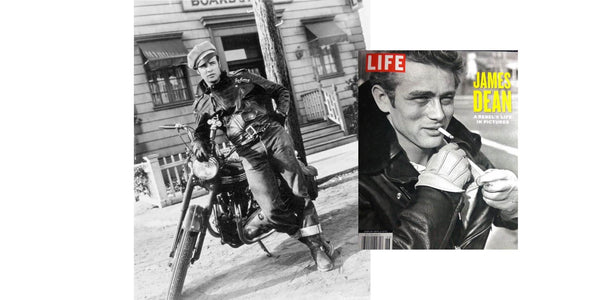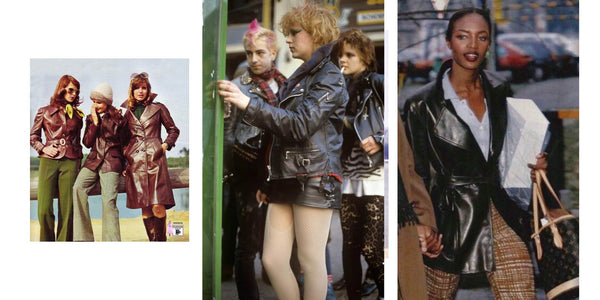Aviators to Rebels: Tracing the Evolution of Vintage Leather Jackets
It's hard to escape the influence of leather jackets. Over the last century, the iconic item of vintage clothing has become a stalwart fashion piece. From being essential for military & motorcyclists to a symbol of rebellion, the leather jacket has come a long way.
We trace the evolution of the leather jacket through a range of styles, from functional flight jacket and bomber jacket, to fashionable slim fit leather blazers and leather coats.
1. Military & Motorbikes

Left: A group of WW2 Aviators, c.1940 Centre: Harley Davidson Motorcylist, 1930 Right: A WASP pilot, May 1949, credit: bill-kelso
In the early 1900s, leather jackets were mainly used as protective gear for military aviators. Also known as flight jackets and bomber jackets, the first military leather jackets were made of sheepskin and were bulky and heavy.
During the world wars, the production of motorcycles ramped up as they became vital to the war effort. Leather jackets were the top choice for motorcyclists because they provided protection and warmth against the weather.
The motorcycle brand, Harley Davidson, played a big role in both WWI and WW2. They produced bikes in the masses which helped to pass messages across enemy lines. After the two wars, biker communities were established - the most notable, Hell's Angels, was established by a war veteran. And, of course, they could be recognised by their black leather jackets.
2. The Influence of Hollywood

Left: Marlon Brando in The Wild One, 1953 Right: James Dean on the Cover of Life Magazine, c.1955
Read our blog on Military Style in the 80s
Post-World wars, leather jackets became aligned with anti-establishment politics, violence and crime. The American ‘outlaw’ motorcycle culture grew and, with it, a general dissatisfaction for mainstream society as a whole.
Hollywood helped to transform the image of the leather jacket. The Wild One (1953), the first film about biker culture gangs, starred heartthrob Marlon Brando wearing an original leather biker jacket, a direct replica of one of the first zip-up leather jackets by Schott Bros, the Perfecto jacket. After the release of this film, the sale of leather jackets skyrocketed.
3. Rock 'n' Roll

Left: American Greaser, c. 1990 Centre: Elvis Presley, NBC Studios, 1968 Right: Leather Boys / Ton-up Boys, 1964
The combination of music, motorbikes and leather could be seen in subcultures across North America and Britain. Rock ‘n’ Roll music came from the group of leather-wearing motorcycle groups - in fact, the name ‘rockers’, referenced a part of an engine. The American Greasers and the British leather boys both wore leather jackets to symbolise their distaste for society and rebellion.
In the 1950s and 1960s, at the back of American motorcycle culture, the Greaser subculture emerged. They were predominantly made up of working class male teenagers and young adults in the U.S. They could be recognised in black leather jackets and slicked back hair - think John Travolta in Grease - and listening to the likes of Eddie Cochran, Little Richard and, of course, style icon Elvis Presley.
Motorcycle culture and its leather get-up filtered its way into the UK. The post-war British biker subculture were known widely as leather boys or ‘cafe racers’ - a reference to the transport cafe’s they’d pass in mass on their journey.
Soon, the biker style eclipsed the motorbike culture itself. Black leather jackets and quiffed up hair was a general symbol of youth and rebellion.
5. Women in Leather

Left: Magazine catalogue, c.1970 Centre: Punks, 1982 Right: Naomi Campbell, c.1990
Shop Women's Vintage Leather Collection
In the later half of the 20th century, women began to adopt the men’s leather jacket and helped to transform the leather jacket beyond biker & rocker subcultures.
The punk rock movement of the 1970s and 80s embraced the leather jacket as a symbol of rebellion. In the early years of her shop Let it Rock (later named SEX), the queen of punk, Vivienne Westwood, sold vintage women’s leather jackets featuring embroidered anarchy symbols. Women punks in the 70s and 80s were no strangers to leather jackets - they could be seen wearing men’s leather jackets with added badges or safety pins.
In popular fashion circles, the slim fit leather coats were all the rage for women. As the Swinging Sixties reached its peak in London, fitted women’s leather jackets helped to create the sleek Mod look. Leather jacket styles evolved in the 70s too, with longer leather trench coats emerging as well as suede jackets and blazers.
In recent decades, women’s leather jackets have become a firm fashion favourite. In the 90s and 00s, supermodels like Kate Moss and Naomi Campbell established the leather jacket as an integral part of their minimalist style.
7. Vintage Leather Jackets Today

In the last two decades, many designers have been inspired by classic vintage leather jackets. Everyone from Michael Kors to Hugo Boss to Ralph Lauren have made leather jackets in recent years, replicating Schott’s Perfecto jacket or a distressed leather jacket.
In reaction to the leather jacket demand of the 20th century, anti-leather campaigns have emerged! Sustainable activist and designer, Stella Mccartney, has led campaigns with Peta (animal rights charity) to stop the production of leather and other animal products altogether as it puts at risk animals, humanity, and the earth.
Choosing vintage leather is the sustainable option. By choosing something that already exists, you’re reducing waste tenfold. Plus the nature of leather as a durable and hardy material means it can last multiple lifetimes. And don’t worry, ROKIT's collection of vintage leather jackets has your back.
REFERENCES:
